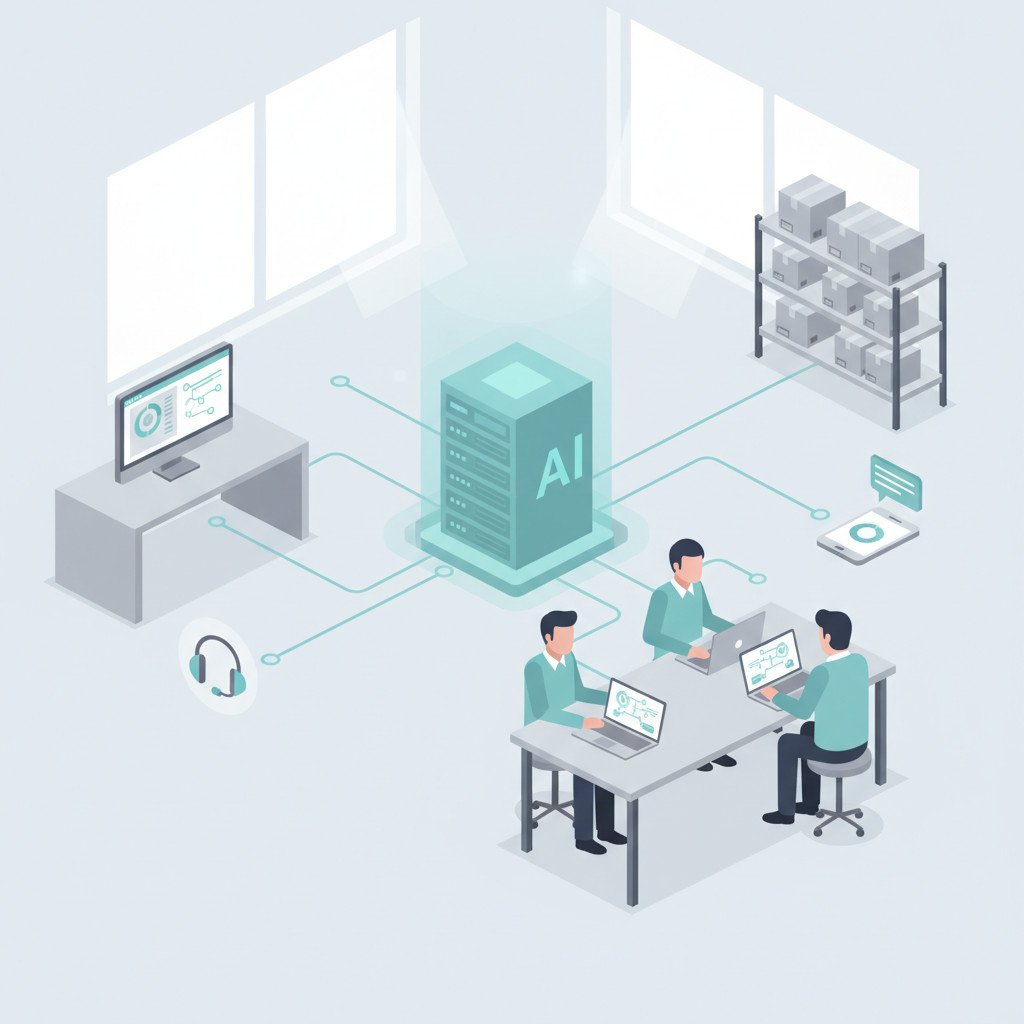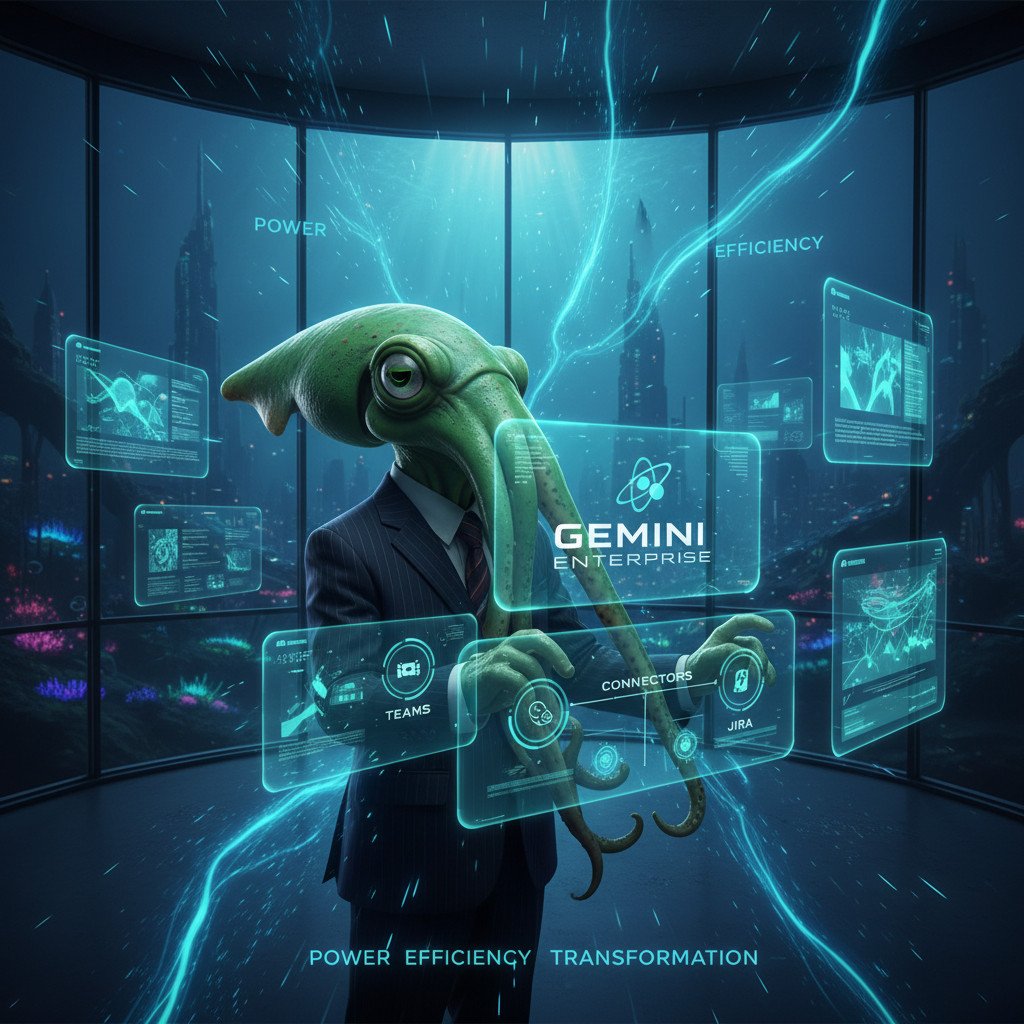AI in the enterprise is transforming business at every level, from customer service to supply chains. Today, companies deploy large language models, intelligent agents, and automation to cut costs and speed decisions. Because AI can synthesize complex data, teams get faster insights and clearer forecasts. However, technology alone is not enough; governance, training, and data strategy must follow.
Leaders who combine tools with culture see measurable gains in productivity and innovation. For example, automated agents can handle repetitive workflows, freeing staff to focus on creative work. Moreover, connected data ecosystems and secure integrations make deployments repeatable. Therefore, staged pilots and rigorous monitoring reduce risk while unlocking value.
This article maps practical steps to adopt enterprise AI, including agent design, model governance, and change management. Along the way, we highlight vendor platforms, real-world wins, and common pitfalls to avoid. By the end, readers will know how to build scalable AI solutions that drive growth, improve efficiency, and preserve trust.
Understanding AI in the Enterprise
What AI in the enterprise means
AI in the enterprise refers to the use of artificial intelligence to improve business processes, decisions, and customer experiences. It covers models, agents, and systems that interact with company data. Because enterprises work with sensitive and scaled data, deployments require governance, security, and integration plans.
Common technologies and platforms
Enterprises use a mix of AI technologies. These include large language models, machine learning, computer vision, and reinforcement learning. In addition, specialist AI agents automate workflows and handle repetitive tasks.
Typical components include:
- Large language models and chat interfaces
- AI agents and no code workbenches
- Data connectors and integration layers
- Model governance and explainability tools
For example, platform launches such as Gemini Enterprise show how vendors bundle models, agents, and connectors for workplace use. Learn more on how Gemini places agents on every desk in this explainer How Can Gemini Enterprise Put AI Agents on Every Desk—and What Does That Mean for Your Workplace?. You can also explore vendor documentation for platform details Gemini Enterprise on Google Cloud.
How enterprises deploy AI
AI deployment follows staged patterns. First, teams run pilots to validate value. Then, they scale with production pipelines and monitoring. Because data pipelines power models, connected data ecosystems speed safe rollout. See practical approaches for connected data ecosystems What are connected data ecosystems for AI at scale and how can they accelerate enterprise AI adoption?.
Enterprise AI benefits and considerations
Enterprise AI benefits include faster insights, lower operational costs, and improved customer service. However, many organizations struggle to capture full value. Therefore, leaders must align strategy, governance, and training to close the AI value gap. For further discussion on realizing measurable returns, read What fixes actually close the AI value remains elusive gap?.
Related keywords and synonyms: AI deployment, enterprise AI benefits, no code workbench, AI agents, model governance, connected data, generative AI, operational automation.
AI in the enterprise benefits
Improved operational efficiency
AI reduces manual work and speeds routine processes. For example, automated agents handle repetitive tasks and approvals. As a result, teams redirect time toward high-value work. Moreover, processing times drop and error rates fall. Therefore, organizations see measurable productivity boosts.
Data driven decision making
AI synthesizes large datasets to surface trends and risks. Because models can analyze unstructured data, leaders gain faster insights. Consequently, forecasting and strategic planning improve. In addition, explainability tools increase trust in model outputs.
Automation and workforce augmentation
AI automates repetitive tasks while augmenting employee output. For example, no-code workbenches let nontechnical staff build agents. Therefore, skill gaps shrink and innovation spreads. However, this requires training and governance to scale responsibly.
Enhanced customer experience
AI powers personalized interactions and faster responses. Chat interfaces and recommendation systems improve satisfaction. As a result, companies can increase retention and lifetime value.
Concrete impact and real world data points
- “Email Ellie boosted content production speed by 40 percent and contributed to a 28 percent year-over-year increase in July sales.” This shows direct revenue impact.
- Companies report lower third-party costs. For instance, Email Ellie helped achieve a 35 percent reduction in agency dependency costs.
- In operations, a multi-agent campaign discovered a 25 percent inventory gap. As a result, teams created a ServiceNow purchase order and fixed stock issues.
- Some deployments scale across entire firms. For example, Macquarie Bank rolled out generative AI companywide, and 99 percent of staff completed training.
Benefits summary
- Faster insights and better decisions
- Lower operational costs and reduced errors
- Scalable automation and higher staff productivity
- Improved customer experience and retention
Because enterprises need governance and connected data, leaders must pair tools with policies. Doing so unlocks the full potential of AI while preserving trust and compliance.

Use Cases: AI in the enterprise
Predictive analytics and risk forecasting
AI models scan large datasets to reveal patterns that humans miss. For example, predictive analytics can forecast demand, detect fraud, and flag supply chain disruptions. As a result, teams move from reactive firefighting to proactive planning. In one pilot, a multi-agent campaign identified a 25 percent inventory gap. Consequently, the team created a ServiceNow purchase order and prevented lost sales.
Sales automation and revenue operations
AI streamlines sales workflows and speeds deal cycles. For instance, automated lead scoring routes high value prospects to reps. Moreover, AI drafts personalized outreach and automates follow-ups. As a result, sales teams close deals faster and spend more time selling. Real-world success includes Email Ellie boosting content production speed by 40 percent, which supported a 28 percent year over year sales lift in July.
Marketing personalization and creative scale
AI enables tailored campaigns at scale. Because models generate creative assets and audience insights quickly, marketers test more variations. Therefore, teams increase conversion rates while reducing agency dependency. For example, Email Ellie reduced agency costs by 35 percent and delivered fresh social assets for campaigns.
Customer support bots and conversational agents
Chat and voice bots handle common questions 24/7. As a result, response times fall and CSAT scores often rise. Furthermore, agents integrate with CRM systems to provide contextual answers. For complex issues, bots escalate to humans with a full interaction summary. This hybrid approach improves both efficiency and trust.
Operations, automation, and workforce augmentation
AI automates repetitive tasks like invoice processing and approvals. Consequently, employees focus on strategy and creative problem solving. Also, no-code workbenches let non-technical staff build agents. Therefore, organizations democratize innovation and close skill gaps quickly.
Developer tools and knowledge work
AI accelerates coding, research, and document summarization. For example, code assist agents reduce debugging time and boost throughput. Moreover, deep research agents synthesize reports from multiple sources, saving analysts hours per week.
Practical takeaway
Across functions, AI drives faster decisions, higher productivity, and lower costs. However, leaders must pair tools with governance and training. Therefore, staged pilots and measurable KPIs help scale wins safely and sustainably.
Comparison of leading platforms for AI in the enterprise
| Tool Name | Primary Function | Key Features | Pricing Model |
|---|---|---|---|
| Gemini Enterprise (Google Cloud) | Enterprise LLMs and intelligent agents | Bundles Gemini models, no code workbench, Model Armor governance, connectors for Teams, Salesforce, Box, Confluence, Jira | Seat based plans; Gemini Business from $21 per seat/month; Enterprise from $30 per seat/month |
| OpenAI (API and ChatGPT Enterprise) | LLM API and conversational assistants | Developer APIs, fine tuning options, enterprise security and compliance controls | Consumption based API pricing plus enterprise contracts and seat licensing for ChatGPT Enterprise |
| Microsoft Copilot and Azure OpenAI | Productivity copilots and cloud LLM hosting | Deep Microsoft 365 integration, Azure security, deployable foundation models, enterprise governance | Per user Copilot subscriptions and Azure consumption billing |
| AWS Bedrock and SageMaker | Model hosting, MLOps and foundation models | Managed foundation models, training and deployment pipelines, monitoring and autoscaling | Consumption based with reserved instance options and enterprise agreements |
| Salesforce Einstein | CRM AI, predictions and automation | Native CRM insights, personalized recommendations, automation of workflows and sales ops | Subscription add on to Salesforce CRM, tiered pricing |
| Anthropic Claude | Secure conversational AI platform | Safety first models, context aware assistants, enterprise privacy features | Usage based API pricing and enterprise plans |
| Databricks AI (Lakehouse) | Data platform plus ML lifecycle | Unified lakehouse for data, model training, feature store, production MLOps | Consumption and subscription bundles depending on workloads |
Tip: Match platform strengths to your priorities. If governance matters, prefer platforms with built in controls. If data scale and MLOps are key, choose a unified data and model platform. Because pricing and integration vary, run pilots to measure total cost of ownership and time to value.
Challenges and Solutions for Implementing AI in the Enterprise
Data privacy and compliance
Challenge: Enterprises handle sensitive personal and business data. As a result, AI projects face regulatory and privacy risks.
Solutions:
- Build a data governance framework with access controls and lineage tracking.
- Use anonymization and differential privacy when possible to reduce exposure.
- Implement continuous audits and logging to prove compliance.
- Prefer platforms with built in protections and enterprise controls, because vendor features can simplify compliance.
Integration complexity and legacy systems
Challenge: Legacy systems and fractured data slow AI deployments and add integration risk.
Solutions:
- Start with an integration inventory to map data sources and APIs.
- Use connectors and middleware to standardize access. For example, enterprise platforms now offer connectors for collaboration and CRM systems.
- Deploy in phases: pilot, scale, and optimize to limit disruption.
- Adopt a connected data ecosystem to make models repeatable and reliable.
Model governance, bias, and explainability
Challenge: Models can be opaque, leading to bias and mistrust among stakeholders.
Solutions:
- Create a model governance board to approve production models and thresholds.
- Use explainability tools and monitoring to detect drift and bias early.
- Apply deployment guardrails and testing suites before releasing models to users.
- Leverage vendor governance features such as Model Armor protections when available.
Employee adoption and cultural change
Challenge: Tools fail when people do not change how they work. Indeed, “any major disruption like AI requires a cultural transformation to be successful.”
Solutions:
- Invest in training and role based upskilling programs. For example, some enterprises achieved near universal training completion across staff.
- Combine no code workbenches with training so business users can build safe automations.
- Reward early adopters and showcase wins to encourage broader adoption.
Cost, ROI and infrastructure
Challenge: AI projects can be expensive and unclear on return.
Solutions:
- Define measurable KPIs early, such as time saved or revenue uplift.
- Run controlled pilots to estimate total cost of ownership.
- Choose flexible pricing models and scale compute to demand to avoid overspend.
Practical rule: pair technology with people and governance. Doing so reduces risk and unlocks sustainable value from AI.

Future trends of AI in the enterprise
The next wave of AI will change how companies operate, compete, and innovate. Because models and agents keep improving, automation will reach deeper into business processes. Moreover, enterprises will move from pilots to production at scale. Therefore, leaders must watch emerging trends and prepare accordingly.
Increased AI powered automation
Expect more end to end automation across departments. Intelligent agents will orchestrate workflows across CRM, HR, finance, and operations. As a result, teams will offload routine decisions and focus on strategy. In addition, no code workbenches will let non technical employees create safe automations quickly.
Advanced predictive analytics and forecasting
Predictive models will combine structured and unstructured data for sharper forecasts. Because models learn from integrated data ecosystems, they will detect risks earlier. Consequently, supply chain and revenue planning will improve. Firms will use this capability to reduce stock outs and increase on time delivery.
Personalization at scale and creative augmentation
Generative AI will create personalized content across channels. Marketers will test many variants quickly and optimize for conversion. Therefore, personalization will boost engagement and lifetime value. Creative teams will use agents to scale ideation while retaining human oversight.
Stronger focus on AI ethics and governance
AI ethics will become a board level priority. Companies will invest in explainability, bias detection, and continuous monitoring. Moreover, vendor features like Model Armor will help enforce guardrails. As a result, trust will become a competitive advantage.
Distributed models and hybrid infrastructure
Hybrid deployments will let firms run sensitive workloads on prem while using cloud models for scale. In addition, lightweight frontier models will power edge use cases. Therefore, infrastructure planning will grow more strategic.
Agent ecosystems and platform marketplaces
Open marketplaces for AI agents will expand. Enterprises will mix first party agents with partner solutions. Consequently, time to value will fall and vendor lock in will ease.
Looking ahead, the most successful firms will pair technology with governance and people. Because cultural change matters, invest in skills, pilots, and measurable KPIs to stay ahead.
EMP0: AI and automation for enterprise growth
EMP0 builds AI powered growth systems that multiply revenue while keeping security and governance front and center. Our platform combines analytics, automation, and creative engines to drive measurable outcomes. As a result, clients scale campaigns faster and reduce third party dependency.
Core tools and capabilities
- Content Engine: Generates on brand copy and assets at scale to accelerate creative programs.
- Marketing Funnel: Orchestrates lead capture, scoring, and conversion pathways with predictive rules.
- Sales Automation: Automates outreach, follow ups, and deal routing to shorten sales cycles.
- Retargeting Bot: Reengages lost prospects across channels using personalized messaging.
- Revenue Predictions: Forecasts pipeline and revenue with advanced models for better planning.
In addition, EMP0 offers proprietary automation tooling. For example, our n8n Discord trigger bots connect communities to workflows. Likewise, we build robust automation workflows that link CRM, analytics, and ad platforms. Therefore, teams get repeatable, secure automations without heavy engineering.
Why clients choose EMP0
- We prioritize data security and governance, because trust matters.
- We combine no code workflows with expert implementation to speed ROI.
- We measure impact with clear KPIs, such as conversion lift and cost per acquisition.
Ready to multiply revenue with secure AI systems? Visit EMP0 to learn more and book a demo: EMP0. For technical integrations and n8n automation examples, see our creator page: our creator page.
AI in the enterprise is not a future promise; it is the engine of today’s competitive advantage. When paired with governance, connected data ecosystems, and employee upskilling, AI delivers faster insights, higher productivity, and measurable revenue gains. Real deployments—from multi agent inventory fixes to content agents that boosted production by 40 percent—show practical value when leaders align people, processes, and technology.
EMP0 helps enterprises translate that potential into outcomes. With tools like Content Engine, Marketing Funnel, Sales Automation, Retargeting Bot, and Revenue Predictions, EMP0 builds secure AI systems that multiply revenue while preserving control. Our proprietary n8n Discord trigger bots and automation workflows accelerate integrations and make growth repeatable.
If your organization is ready to scale AI responsibly, EMP0 offers the expertise and tooling to get there faster. Explore our solutions and book a demo at EMP0 to start your AI journey.

